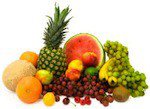Calories in Fruit
 Fruit is made up of mostly simple carbohydrates, some proteins, and very little fat – of course there are exceptions such as avocado.
Fruit is made up of mostly simple carbohydrates, some proteins, and very little fat – of course there are exceptions such as avocado.
Fruit is not just about calories, but other health benefits that are available.
However during a fat-reducing program, all simple sugars should be eaten in moderation. But don’t go too overboard – fruit contains many healthy nutrients – antioxidants, vitamins, and fiber.
Fruit Calories and Macronutrients
| Fruit | Serving | Calories | Carbs (g) |
Protein (g) |
Fat (g) |
|---|---|---|---|---|---|
| Apple | raw, with skin, 100g = 1 small | 52 (218 kj) | 13.8 | 0.3 | 0.2 |
| Apricot | raw, with skin, 100g = 3 apricots | 48 (201 kj) | 11.1 | 1.0 | 0.4 |
| Avocado | raw, no skin, 100g | 160 (670 kj) | 8.5 | 2.0 | 14.7 |
| Banana | 1 medium | 94 (393 kj) | 21.7 | 1.1 | 0.3 |
| Boysenberries | raw, 1 cup | 75 (312 kj) | 18.4 | 1.0 | 0.6 |
| Blueberries | raw, 1 cup | 81 (339 kj) | 20.5 | 1.7 | 0.6 |
| Dates | 1 cup, pitted, chopped | 490 (2047 kj) | 130.8 | 3.6 | 0.7 |
| Grapefruit | 1 medium | 82 (343 kj) | 20.5 | 1.5 | 0.3 |
| Grapes | 1 cup, seedless, red or green | 114 (475 kj) | 28.3 | 1.0 | 1.0 |
| Kiwi fruit | 1 medium, 2.7oz, no skin | 46 (194 kj) | 11.2 | 0.8 | 0.3 |
| Lemon | 1 medium, 2oz | 17 (70 kj) | 5.4 | 0.6 | 0.2 |
| Melon | Cantaloupe, 1 medium wedge, 2.4oz | 24 (101 kj) | 5.7 | 0.6 | 0.2 |
| Nectarine | 1 medium | 67 (279 kj) | 15.9 | 1.2 | 0.5 |
| Oranges | 1 large, 6.5oz | 86 (361 kj) | 21.5 | 1.7 | 0.2 |
| Peaches | 1 medium, 3.5oz | 42 (176 kj) | 10.8 | 0.7 | 0.0 |
| Pear | 1 medium, 5.8oz | 98 (410 kj) | 25.1 | 0.7 | 0.7 |
| Pineapple | 1 cup, diced, 5.5oz | 76 (318 kj) | 19.2 | 0.6 | 0.6 |
| Plums | 1 medium, 2.3oz | 36 (152 kj) | 8.6 | 0.5 | 0.4 |
| Raspberries | 1 cup, 4.3oz | 60 (252 kj) | 14.1 | 1.2 | 0.6 |
| Strawberries | 1 cup, halves, 5.4oz | 46 (190 kj) | 10.6 | 0.9 | 0.5 |
| Watermelon | 1 wedge, 10oz | 92 (383 kj) | 20.6 | 1.7 | 1.1 |
Can’t find it? See the full range of fruits and fruit juices.
Fruit and Health
Your level of fruit consumption is associated with lower cancer risk, and the risk of heart failure. However, note that many of these studies looked at fruit and vegetable consumption, one study noted that higher vegetanle consumption (but not fruit) was linked to a slowed cognitive decline on older age.
When following a weight loss diet, it is advised to continue consuming fruit, in order to keep antioxidant levels up.
References
- Bradbury, K. E., Appleby, P. N., & Key, T. J. (2014). Fruit, vegetable, and fiber intake in relation to cancer risk: findings from the European Prospective Investigation into Cancer and Nutrition (EPIC). The American journal of clinical nutrition, 100(Supplement 1), 394S-398S. Link
- Morris, M. C., Evans, D. A., Tangney, C. C., Bienias, J. L., & Wilson, R. S. (2006). Associations of vegetable and fruit consumption with age-related cognitive change. Neurology, 67(8), 1370-1376. Link
- Crujeiras, A. B., Parra, M. D., Rodríguez, M. C., Martínez de Morentin, B. E., & Martínez, J. A. (2006). A role for fruit content in energy-restricted diets in improving antioxidant status in obese women during weight loss. Nutrition, 22(6), 593-599. Link